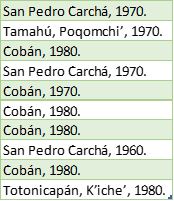See below some of the photos of the collection of Mayan güipiles of high cultural value that the Historical Museum of the Verapaces received.Good news! Recently the Historical Museum of the Verapaces received a collection of güipiles originating from Alta Verapaz and one from Totonicapán, which were donated. This collection of high cultural value is called “Weaving our history: a journey through the past, the present and the future”.This delivery seeks to promote respect for the traditions and customs of the Mayan Q’eqchi’ culture. Look at some of the photographs!
They delivered güipiles of Alta Verapaz to the Historical Museum of the Verapaces
In order to preserve and promote the value of the Q’eqchi’ Mayan culture, Guatemalan María del Carmen Prahl Redondo de Paredes donated 10 güipiles to the Historical Museum of the Verapaces, located in the department of Alta Verapaz .As it is known, prior to the delivery, the pieces were curated by Violeta Gutiérrez who is director of the Technical Department and Deputy Curator, of the Ixchel Museum of Indigenous Costume.
To carry out this process it was done:
Dry cleaning, through a vacuum cleaner and frame.Decontamination, which is done by placing the pieces in a freezer to minimize their deterioration.With these mechanisms used by the Ixchel Museum, the use of chemicals is avoided and, on the contrary, special materials are used, appropriate to the degree of conservation for each piece.
Mayan Güipiles that were delivered
 These Mayan textiles will be part of a permanent exhibition, which will be located within the facilities of the Museum of Governance, of that locality. What pride!The collection consists of 10 güipiles duly curated by Violeta Gutiérrez, director of the Technical Department and Deputy Curator, of the Ixchel Museum of Indigenous Costume.
These Mayan textiles will be part of a permanent exhibition, which will be located within the facilities of the Museum of Governance, of that locality. What pride!The collection consists of 10 güipiles duly curated by Violeta Gutiérrez, director of the Technical Department and Deputy Curator, of the Ixchel Museum of Indigenous Costume.
“The processes that were used during the project were: dry cleaning, through a vacuum cleaner and frame; and decontamination, which is done by placing the pieces in a freezer to minimize their deterioration. In the museum we work on preventive conservation, that is, we do not use chemicals, but special materials are used, appropriate to the degree of conservation for each piece,” said Gutiérrez.
Hidroeléctrica Renace aware of the importance of sustainable social development, since 2012, implements a strategy of shared social value that supports all stages of development of the human person, through 7 programs, in 29 Maya Q’eqchi ́ communities neighboring the project. Also, this strategy seeks to support the achievement of the Sustainable Development Goals – SDGs – and the 2030 agenda.
